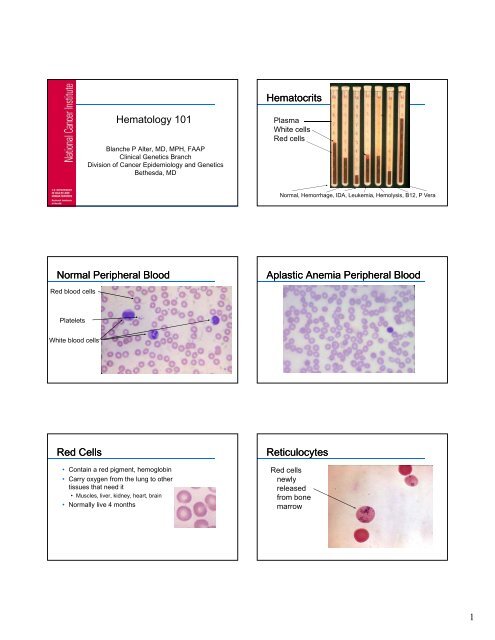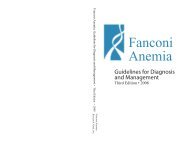Aplastic Anemia Peripheral Blood
Aplastic Anemia Peripheral Blood
Aplastic Anemia Peripheral Blood
Create successful ePaper yourself
Turn your PDF publications into a flip-book with our unique Google optimized e-Paper software.
Hematocrits<br />
Hematology 101<br />
Blanche P Alter, MD, MPH, FAAP<br />
Clinical Genetics Branch<br />
Division of Cancer Epidemiology and Genetics<br />
Bethesda, MD<br />
Plasma<br />
White cells<br />
Red cells<br />
Normal, Hemorrhage, IDA, Leukemia, Hemolysis, B12, P Vera<br />
Normal <strong>Peripheral</strong> <strong>Blood</strong><br />
<strong>Aplastic</strong> <strong>Anemia</strong> <strong>Peripheral</strong> <strong>Blood</strong><br />
Red blood cells<br />
Platelets<br />
White blood cells<br />
Red Cells<br />
• Contain a red pigment, hemoglobin<br />
• Carry oxygen from the lung to other<br />
tissues that need it<br />
• Muscles, liver, kidney, heart, brain<br />
• Normally live 4 months<br />
Reticulocytes<br />
Red cells<br />
newly<br />
released<br />
from bone<br />
marrow<br />
1
Fetal Hemoglobin<br />
Kleihauer-<br />
Betke stain<br />
Platelets<br />
• Help blood clot<br />
• Live 7-10 days<br />
• Low numbers can lead to:<br />
• Bruising<br />
• Petechiae (tiny red dots)<br />
• Nosebleeds<br />
• Internal bleeding<br />
Platelets<br />
Types of White Cells (Leukocytes)<br />
Type<br />
Life Span<br />
Phagocytes (eaters):<br />
Neutrophil hours<br />
Monocyte days<br />
Eosinophil hours<br />
Basophil hours<br />
Lymphocytes months-years<br />
White <strong>Blood</strong> Cell Functions<br />
• Neutrophils - eat bacteria and fungus<br />
• Lymphocytes - direct the other cells and<br />
make antibodies<br />
• Monocytes - eat particles coated with<br />
antibody<br />
• Eosinophils - allergies and fight parasites<br />
• Basophils - allergies<br />
Neutrophils (Phagocytes)<br />
• Polymorphonuclear (PMN), segmented,<br />
granulocytes<br />
• Bands, juveniles = early forms<br />
• First line of defense against bacterial<br />
infection is intact skin and lining of the<br />
mouth, throat and intestines<br />
• Second line of defense is neutrophils,<br />
which eat bacteria and kill them<br />
• Low neutrophil number increases<br />
susceptibility to bacterial and fungal<br />
infections<br />
Lymphocytes<br />
• Regulate other white cells<br />
• Make antibodies<br />
• Proteins that act as flags to<br />
stick to bacteria and viruses<br />
• Tell other cells to eat things<br />
2
Monocytes<br />
• Phagocytes<br />
• Become tissue macrophages<br />
• Cells in the tissues that eat<br />
particles tagged with antibodies<br />
CBC Machine<br />
• Draw blood from the<br />
tube into an electronic<br />
counter<br />
• Result is called the<br />
complete blood count<br />
(CBC)<br />
Y<br />
Bacterium tagged<br />
by an antibody<br />
<strong>Blood</strong> Counts<br />
WBC<br />
RBC<br />
Hb<br />
Hct<br />
MCV<br />
MCH<br />
MCHC<br />
RDW<br />
Plat<br />
MPV<br />
Red Cells<br />
• Hemoglobin (Hb, Hgb)<br />
• 12-15 grams/100 ml (g/dl) [lower<br />
for children]<br />
• Hematocrit (Hct)<br />
• 35 to 45%<br />
<strong>Anemia</strong> = Low Hb/Hct (H/H)<br />
Platelets<br />
• Platelet count (Plt)<br />
• 150,000 to 400,000/μl<br />
Thrombocytopenia = low platelets<br />
White <strong>Blood</strong> Cells (Leukocytes)<br />
• WBC = white blood cell count<br />
• 5000–10,000/μl, 5 – 10 thousand/μl<br />
• WBC differential<br />
• % Neutrophils, bands, lymphocytes,<br />
monocytes, eosinophils, basophils<br />
Leukopenia = low WBC<br />
3
Absolute Neutrophil Count (ANC)<br />
• ANC = WBC x % Neutrophils<br />
• e.g. WBC = 5000/μl, 30% neutrophils<br />
• ANC = 5000 x 0.30 = 1500/μl<br />
• Normal: above 1500/μl<br />
• OK: above 500<br />
• Low: 200-500<br />
• Very low: below 200<br />
Neutropenia = low neutrophils<br />
CBC Summary<br />
• Quick and easy assessment of numbers<br />
of blood cells<br />
• Relatively inexpensive<br />
• No single test tells us more about a blood<br />
disorder<br />
• Measures all three cell types (RBC, WBC,<br />
platelets)<br />
• Provides other valuable details<br />
Causes of <strong>Anemia</strong><br />
• Decreased production<br />
• Decreased reticulocytes<br />
• Increased destruction<br />
• Increased reticulocytes<br />
• <strong>Blood</strong> loss<br />
• Increased reticulocytes<br />
Definitions<br />
• <strong>Aplastic</strong> <strong>Anemia</strong> (AA):<br />
• Pancytopenia due to decreased<br />
production<br />
• Hypocellular bone marrow<br />
• Leukemia:<br />
• Malignant proliferation of immature cells<br />
• Myelodysplastic syndrome (MDS):<br />
• Cytopenia with hypercellular bone<br />
marrow<br />
Bone Marrow Equipment<br />
Bone Marrow Biopsy<br />
Normal<br />
<strong>Aplastic</strong><br />
Aspirate<br />
Biopsy<br />
4
Normal Bone Marrow Aspirate<br />
<strong>Aplastic</strong> <strong>Anemia</strong> Bone Marrow<br />
Aspirate<br />
Erythroid (red cells)<br />
Myeloid (white cells)<br />
Bone Marrow Iron<br />
Leukemia Bone Marrow<br />
Hematopoiesis<br />
• Formation and development of<br />
blood cells<br />
• Takes place in the bone marrow<br />
• Involves “stem cells”<br />
5
Hematopoiesis<br />
BM Cultures<br />
• CFU-E: colony-forming unit, erythroid<br />
• BFU-E: burst-forming unit, erythroid<br />
• CFU-C: colony-forming unit in culture<br />
• CFU-GM: colony-forming unit,<br />
granulocyte-macrophage<br />
CFU-E and BFU-E<br />
Dysplastic Marrow in MDS<br />
• Erythroid: megaloblastic, multinucleation,<br />
nuclear fragments, increased immature<br />
forms, ring sideroblasts<br />
• Myeloid: increased immature forms,<br />
hypo/hyper-granulation<br />
• Megakaryocytes: hypo-/hyper-lobulated,<br />
small forms, increased nuclearcytoplasmic<br />
ratio<br />
Bone Marrow in MDS - Erythroid<br />
Bone Marrow in MDS - myeloid and<br />
megakaryocytic<br />
6
FAB CLASSIFICATION<br />
• No MDS<br />
• RA = refractory anemia<br />
• RARS = ring sideroblasts<br />
• RAEB = RA with excess blasts (5-20%)<br />
• CMML = chronic myelomonocytic<br />
leukemia, PB monocytes >1000/μL<br />
• RAEBT = RA in transformation<br />
French-American-British<br />
WHO Classification<br />
RCUD: refractory cytopenia with unilineage<br />
dysplasia (>10% cells in one lineage)<br />
• RA, RN, RT: anemia, neutropenia, thrombocytopenia<br />
RARS: ring sideroblasts<br />
RCMD: multilineage dysplasia (>2 lineages)<br />
RAEB-1: 5-9% blasts<br />
RAEB-2: 10-19% blasts<br />
MDS-U: unclassified: dysplasia
















